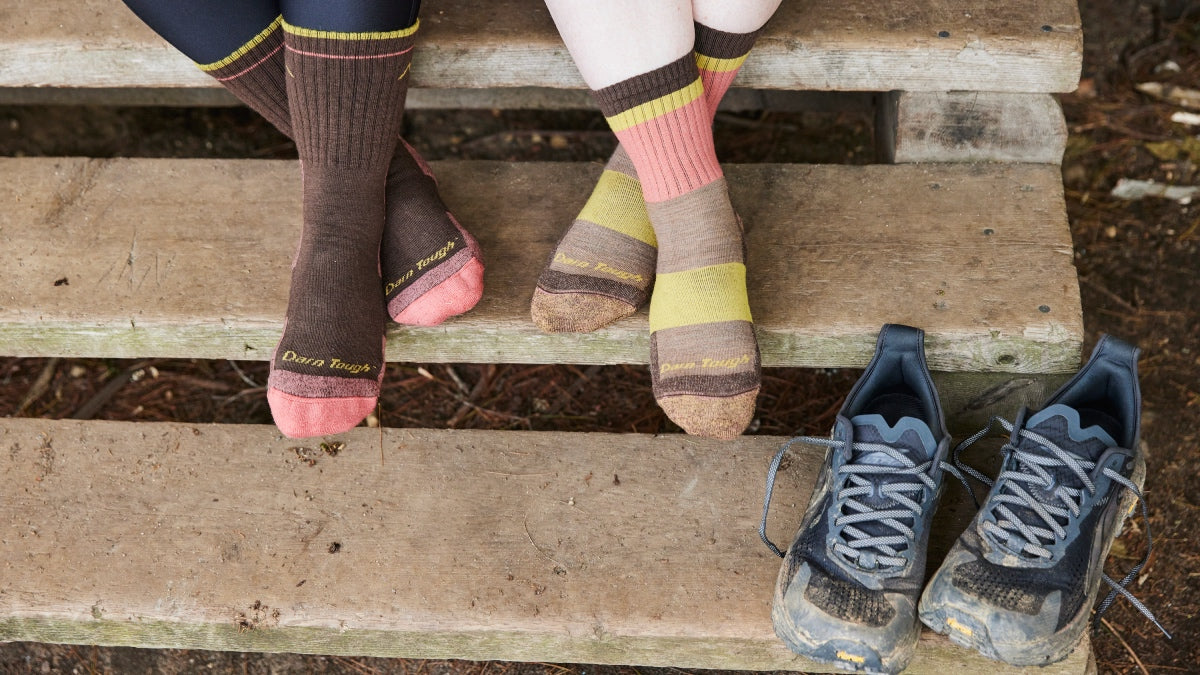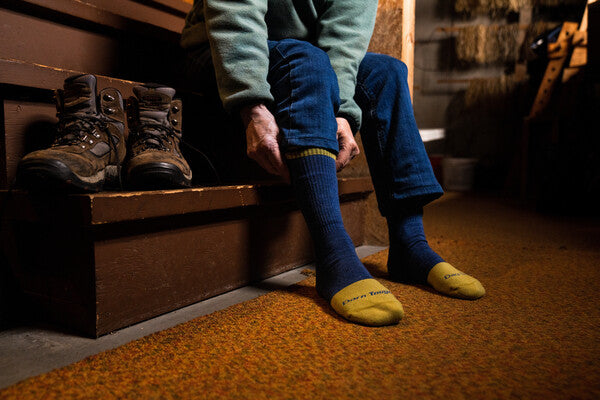Why You Don’t Want 100% Merino Wool Socks

If you’re familiar with how we talk about socks, chances are that headline surprises you. It’s no secret that we tout Merino Wool as the best material for socks. And After 20 years, we still do.
But there is such a thing as having too much of something good. Think Bruce coming face to face with the infamous chocolate cake in Matilda. So in this post we’re going to cover the finer points of sock materials, from yarn selection to construction, answering questions like:
- Is 100% Merino Wool good quality?
- Can you have 100% wool socks?
- What percentage of Merino Wool in socks is best?
The answers are more nuanced than you might think (hence the lengthy post), but we’ll get you there. We promise. First things first though...
What Is 100% Merino Wool?
Merino Wool is a fiber that grows on a specific breed of sheep – namely, the Merino sheep. For a fabric (or piece of clothing) to be 100% Merino Wool, it must be made entirely with Merino Wool yarn, and that yarn must be made with only Merino Wool, sourced from Merino sheep.
Some wool yarns are truly blends. The Merino fibers are spun together with other fiber types (like acrylic or cotton) into one yarn. This means any fabric knit or woven from that yarn – even if it’s the only yarn used — is not 100% Merino Wool. These yarns and the garments made with them are often less expensive than garments that use 100% Merino Wool yarns.
Of course, you can use 100% Merino Wool yarns to make clothing that is not 100% Merino Wool. It’s become common practice to knit or weave in other yarn types to take advantage of the properties of other fibers. But a 100% Merino Wool garment is made using 100% Merino Wool yarns (no blends) and only those yarns.
Is 100% Merino Wool Good Quality?
Maybe. Consider this:
Quality starts with the Merino sheep itself. Is that sheep healthy? A healthy, well-cared for sheep produces high quality fibers. An unhealthy Merino sheep still produces Merino Wool, but the quality of that wool may be subpar.

Assuming high quality Merino fibers, the next piece in determining quality is how those fibers are processed into ready-to-use yarns. There are many steps involved in turning Merino fibers into Merino yarns. A careful process preserves the quality of the fibers, while a careless process could damage them.
We won’t cover all the steps, but for example: dyeing the yarn. If you know someone who’s had a bad hair-dyeing experience, you can likely guess how poor dye processes could harm the quality of Merino yarns.
What’s the point here? You could purchase a 100% Merino Wool garment that isn’t great quality. That’s part of why sheep farming and wool processing standards like the Responsible Wool Standard (RWS) exist. These third-party certifications let you have confidence that the wool being used was grown, harvested, and processed at a high standard and in an ethical, sustainable way.
Assuming the wool was grown and processed carefully, then yes, 100% Merino Wool yarns are excellent quality. These yarns harness all the amazing benefits of Merino Wool, from regulating temperature to wicking moisture.
Is 100% Merino Wool Worth It?

Personal factors come into play here (i.e. budget, intended use case), but we’re of the opinion it’s always worth it to make sure the Merino Wool in your garments is from 100% Merino Wool yarns, never blends.
But is 100% Merino Wool clothing worth it? It depends on what piece of clothing you’re talking about. To answer this question, let’s consider the pros and cons of Merino Wool:
Pros
- Breathable
- Moisture wicking
- Temperature regulating (aka it keeps you warm on cold days and cool on hot days)
- Anti-odor and anti-microbial
- Soft and silky (this ain't your grandma's wool)
- Natural
Cons
- Expensive
- Not as durable
- Not as elastic
We’ve spent a lot of time covering the pros of Merino Wool elsewhere, so let’s dive into the cons.
Merino Wool is an amazing natural fiber, but it’s more expensive to produce than many other alternative fabrics, especially synthetic materials. A 100% Merino Wool garment is going to be more expensive than a partially or completely synthetic alternative.
Merino fibers are naturally durable and elastic – they’re incredibly good at stretching and rebounding. You might even call them nature’s best. But this is where synthetic fibers like Nylon and other polyesters have an edge – these man-made fibers are even more durable. And the natural elasticity of Merino Wool cannot compare to the stretchiness of elastics like Spandex.
In other words, taking 100% Merino Wool yarns and then strategically knitting or weaving them with other high-quality yarns can let you combine all the strengths of Merino Wool with the strengths of those fibers. The end result? A more durable, better-fitting garment.
For Example

Let's consider these two examples:
- A long sleeve shirt as a hiking base layer. Chances are you’re wearing this garment under other clothing, so it’s not going to be exposed to branches and rocks. You’re also wearing it on the top half of your body, a relatively low-impact area. The shirt hangs down from your shoulders, so it doesn’t need to be held up, meaning if you get a good fit, you don’t necessarily need the support of an elastic.
- A pair of hiking socks. These sit under your feet, bearing the entire impact of your body contacting the ground with every step. They also rub against your footwear, typically a stiff material that creates a lot of friction with the sock (which is protecting your foot from said friction). Unlike a shirt, these socks must hold themselves up as gravity tries to pull them down your leg and off your foot.
In the above example, a 100% Merino Wool shirt could be a great choice. It won’t be as durable per se as a shirt that’s 60% Merino Wool and 40% Nylon, and it won’t be as stretchy as if you threw in some Spandex, but you’ll certainly have a high-quality garment suited to your activity.
Conversely, a 100% Merino Wool sock would not be a good choice. In socks, the Spandex is essential for a performance fit to prevent blisters and hold your sock in place (you wouldn’t wear a wool sweater on your feet). It doesn’t take much elastic to accomplish this – maybe 3-5% of the total material composition – but that little bit makes a huge difference in fit.
Could you make a sock with just Merino Wool and Spandex? Theoretically you could. But we’re interested in making the best socks, socks that will last hundreds if not thousands of miles, year after year. And over 20 years of warranty data, testing, and consumer feedback have shown that strategically adding Nylon in high-wear zones makes your sock last that much longer.
What Percent of Merino Wool Socks Is Best?

That leads us to the big question. Because if the answer isn’t 100% Merino Wool, then what is? Remember, you do want the Merino Wool yarn used in the socks to be 100% Merino Wool yarn... but that’s not to say that yarn can’t be knit together with other yarns to make a better sock.
Understanding Percentages
Some math required for this part. Before we can recommend a percentage, you must understand how percentages work. Percentages in socks are like pie charts – you can never have more than 100% of a sock and you can never have less than 100% of a sock. If one part of the pie chart gets bigger, the other parts get smaller, even if the total quantity didn’t change.
Lost yet? Here, consider this example for clarification:
Our Hiker Micro Crew Midweight and Hiker Micro Crew Lightweight socks both use essentially the same amount of Nylon and Spandex. But if you compare the material breakdowns for these socks, they look quite different:
- Men’s Heady Stripe: 48% Merino Wool, 45% Nylon, 7% Spandex
- Men’s 1466 Hiker: 61% Merino Wool, 36% Nylon, 3% Spandex
So if these socks have the same breakdown of Nylon and Spandex, why do the numbers look different? Because the amount of Merino Wool has changed. The Heady Stripe is a Lightweight sock, meaning we knit it with a finer (aka thinner) Merino Wool yarn. This thinner yarn means that even if we used the exact same length of yarn in the sock, it’d still have less Merino in total than the 1466 Hiker.
Now let’s consider the opposite scenario. Say we use the same amount of midweight Merino yarn in two socks (e.g. each sock contains 400 yards of the same Merino yarn). But one is a Run sock while the other is a Lifestyle sock. That Run sock is going to need more durability built into specific sections that are typically high wear in running shoes.
So, what do we do? We add more Nylon into that sock. The result? The Lifestyle sock ends up having a higher percentage of Merino Wool, even though the actual amount in the sock is identical.
The Answer (Kind of)
What does all this mean? It means there’s no hard and fast rule for what percentage of Merino Wool is best for any particular sock.
If you look at the material compositions of our socks, you’ll find almost no two are exactly the same. Part of that is because of how percentages work, and part of that is because we’re dedicated to making the best sock for a given activity.
If a sock needs more Spandex to stay in place in a ski boot, we add it. If a sock needs more Nylon up the Achilles to protect against boot rub, we add that too.

The best socks, in our experience, are a mixture of three ingredients: Merino Wool, Nylon, and Spandex (aka Lycra). Combining these three fibers creates a sock that’s breathable, durable, thermoregulating, and one that will stay in place with every step.
That said, if you’re buying a “Merino Wool sock” that’s only got 10% Merino Wool in it… you’re probably not going to benefit from the Merino. In the same way that you don’t want a 100% Merino Wool sock, you also don’t want a 10% Merino Wool sock.
Merino Wool All the Way
There you have it. Merino Wool makes the best socks, and it does its best work when it’s strategically combined with materials that support its (few) weaknesses.
Summing it all up: You don’t need 100% Merino Wool socks. But you do need high quality Merino Wool socks. And lucky for you, Darn Tough’s got you covered.







